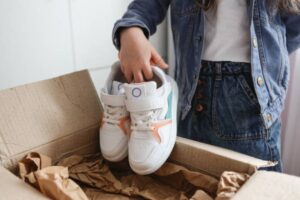Children spend a lot of time in shoes and it’s important that they’re comfortable. When they’re not tripping or falling over themselves, they can learn and have fun.
When learning how to choose kids shoes, shop with your child to get a proper fit and let them choose the color and style. It’s also important to always buy for the larger foot.
Toes
 Kids’ feet need plenty of room in shoes to grow properly and prevent foot problems like blisters, ingrown toenails, and corns. When you measure their feet, leave about a thumb’s width of space at the end of each foot in order to ensure that there is enough wiggle room.
Kids’ feet need plenty of room in shoes to grow properly and prevent foot problems like blisters, ingrown toenails, and corns. When you measure their feet, leave about a thumb’s width of space at the end of each foot in order to ensure that there is enough wiggle room.
Children’s feet come in many shapes and sizes, so their shoes should be shaped to match the shape of their foot. Shoes that are too narrow cause painful rubbing in the toe box and don’t allow for adequate foot movement. Shoes that are too wide can be uncomfortable for kids because their toes are squished and do not provide sufficient support.
The last (the mold from which the shoe is made) must fit to children’s feet well, too. Ideally, the shoe should have a straight last, which conforms to the shape of young children’s feet. Unfortunately, many lasts for shoes – even ones labeled “children’s” – are flared inward for the sake of fashion and profitability.
When trying on shoes, press down on the toe area and see if you can insert your child’s thumb in between their foot and the end of the shoe. This will allow you to feel if there is enough room for their toes, and whether the shoes fit snugly around the mid foot or are too loose in the forefoot area.
Arches
The old-fashioned notion was that children’s feet need extra support and a firm sole to develop arches, but this can actually hinder foot development. Instead, shoes should cradle your child’s foot and promote sensory feedback without touching or rubbing against the top of the ankle bones.
Kids shoes should fit snugly, but they also need to be flexible. “The toes and arch of a healthy foot need to be able to move,” Capobianco says. The best shoes will have a wide, flat toe box that provides room for toes to wiggle and move naturally, she adds.
Learn how to choose kids shoes and start by choosing those that have a padded collar and soft, paddled outsole to help your kiddo feel the ground underneath them, while still providing plenty of protection. You should be able to insert the tip of your thumb between your child’s heel and the front of the shoe to check for enough depth; a narrow gap indicates that the shoes are too deep.
Soles
Children’s feet are not fully developed, so they need shoes that are shaped like their foot and include room to grow. It’s also important that kids shoes are flexible, as active feet can shift around within the shoe. Choosing shoes with rounded toe boxes that leave room for toes to flex will prevent cramping.
When your child is trying on shoes, have them stand up and wiggle their toes in the shoe to check for a comfortable fit. “The correct size will leave about a thumb width between the end of your child’s longest toe and the front of the shoe,” says Dr. Nicolosi. “Any less space is too small.” She recommends having kids wear their shoes for a little while to see if they feel good and have no uncomfortable pressure points or slippage.
Remember that most people, including children, have one foot slightly larger than the other. Always fit a shoe on the larger foot to avoid a tight fit that can cause toes to curl.
Closures
You must also factor in the close when learning how to choose kids shoes. Choosing the right shoe closure can help your child keep their shoes on and avoid the need to grip their toes to prevent them from falling off. It also lets them move and feel the ground with ease. If kids must struggle to keep their shoes on, it can interfere with their natural foot development.
For young toddlers and preschoolers, it’s best to choose Velcro or other fastening styles that are easy for them to handle. These types of closures can be adjusted easily to loosen or tighten around the foot’s width. They’re also quick and easy to fasten, which can help if they’re running or playing outside and might need to get their shoes on quickly.